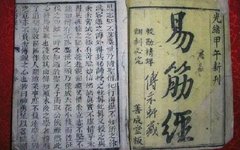The Yi Jin Jing (易筋经) is said to have been transmitted by the monk Bodhidharma from India, who traveled eastward, spreading teachings along the way, eventually arriving at the Shaolin Temple. Bodhidharma possessed profound internal power and meditated facing a wall for nine years, leaving his shadow imprinted on the stone wall. After realizing the significance of his practice, he left behind two secret texts: one is the Xisui Jing (洗髓经), and the other is the Yi Jin Jing. The Xisui Jing is a classic of internal cultivation, attributed to Huike, and has not been transmitted to the world. The Yi Jin Jing is a text for external cultivation, preserved at Shaolin, and has been passed down to this day. However, modern archaeological evidence suggests that the Yi Jin Jing was actually created by the Daoist Ziyin Dao Ren during the late Ming Dynasty, originally a Daoist method of guiding energy, and has no connection to Buddhism.
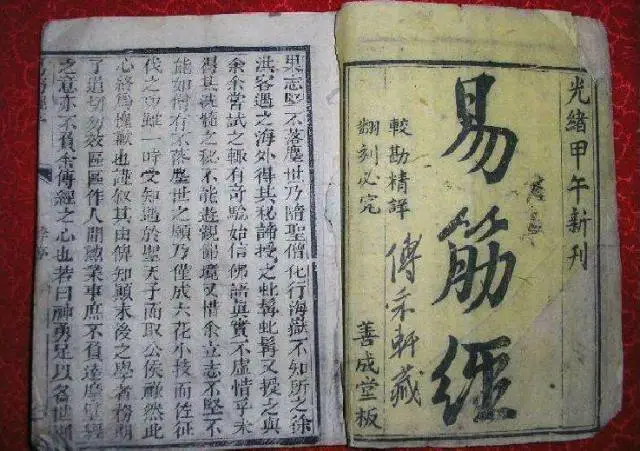
Yi Jin Jing
Introduction to the Practice
“Yi” means to change, transform, or exchange; “Jin” refers to muscles and tendons; “Jing” implies a guide or classic. The Yi Jin Jing is a method for transforming the muscles and tendons. According to the original practice requirements, one must first practice internal cultivation for about a year: only after achieving internal strength can one practice the Yi Jin Jing, and then further practice the Xisui Jing. During this period, one must also take internal and external medicinal aids, and it takes about three years to achieve great success. Due to the lengthy process of practice, few follow the original method, and the Yi Jin Jing that has circulated in modern times mostly extracts the guiding content, differing from the original practice, leading to various styles. The most widely circulated version is the Yi Jin Jing Twelve Postures compiled and edited by Pan Wei during the Qing Dynasty.
In the pseudo-preface attributed to Li Jing from the fourth year of the Ming Tianqi era, there is an explanation regarding the naming and meaning of “Yi Jin.” In the Northern Song Dynasty during the Jingde era (1004-1007), Dao Yuan wrote about the transmission of Zen Buddhism in the Jingde Chuan Deng Lu, which includes a dialogue between Bodhidharma and his disciples. Bodhidharma’s responses to his disciples were evaluated as “gaining my skin,” “gaining my flesh,” or “gaining my bones,” but the highest praise was given to Huike, who was said to have “gained my marrow.” The terms skin, flesh, bones, and marrow are metaphors, not literal references, but rather indicate the level of understanding of his Zen teachings. This pseudo-preface derived from Bodhidharma’s statement about the second patriarch Huike “gaining my marrow” suggests that Bodhidharma transmitted the Xisui Jing to Huike, emphasizing that it was not mere “idle talk.” As for “Yi Jin,” this preface emphasizes the importance of “Jin” in “connecting the whole body and circulating blood and qi.” In the main text of the Yi Jin Jing, the General Discussion states that “Yi” means “change,” and “Jin” refers to the meridians of the human body; it is believed that the human body has both internal and external aspects, with “Xisui” able to “purify the internal,” and “Yi Jin” able to “strengthen the external.” After practicing “Xisui” and “Yi Jin,” one can experience the Buddha’s path and enjoy longevity.
In fact, the name “Yi Jin” originates from Daoist literature and is not a term created by Buddhism. Scholars have pointed out that in the Daoist text Yun Ji Qi Qian (云笈七签) by Zhang Junfang during the Song Dynasty, there are already references to “Yi Sui” and “Yi Jin.” Even earlier, in the Daoist novel Han Wu Di Nei Zhuan, which appeared during the Wei and Jin dynasties, the concept can be found. The Han Wu Di Nei Zhuan states, “In the first year, change the qi; in the second year, change the blood; in the third year, change the essence; in the fourth year, change the pulse; in the fifth year, change the marrow; in the sixth year, change the bones; in the seventh year, change the muscles; in the eighth year, change the hair; in the ninth year, change the form,” which describes an ideal of Daoist practice for longevity. Therefore, “Yi Jin” originally belongs to Daoist thought, and combined with the fact that the Yi Jin Jing includes “matching the principles of yin and yang,” uses young women for massage, and even contains elements similar to Daoist sexual practices, as well as the fact that the Yi Jin Jing was first published by the Daoist Ziyin Dao Ren, it can be concluded that the Yi Jin Jing is indeed a Daoist practice and has no relation to Bodhidharma.
The content of the Yi Jin Jing includes the ideal effects that can be achieved through practice and specific methods of practice. The most significant influence on martial arts novels is the mention of internal strength and external strength. The term “internal strength” states that after practicing this method, “divine power arises from the bones, and with prolonged effort, the arms, wrists, fingers, and palms become extraordinary, as hard as iron and stone, and one can pierce through a cow’s belly with a finger, or break a cow’s head with a palm,” which are merely “minor skills.” The term “external strength” states that after completion, “one can lift city gates and raise cauldrons,” which is not considered extraordinary. Since the beginning of the Daoguang era, martial arts novels have mentioned the Yi Jin Jing, emphasizing the miraculous effects described in the Yi Jin Jing after completion.
The Yi Jin Jing includes both internal and external training methods, each with 12 postures. The internal practice of the Yi Jin Jing adopts a standing posture, using specific positions and breathing techniques to gradually enhance the functions of the meridians and organs. Most practices involve static exertion. Breathing should be comfortable and natural, avoiding forceful exhalation.
The ancient transmitted postures and training methods of the Yi Jin Jing consist of 12 postures, namely Wei Tuo Xian Chu (韦驮献杵) (3 postures), Zhai Xing Huan Dou (摘星换斗), San Pan Luo Di (三盘落地), Chu Zhua Liang Chi (出爪亮翅), Dao Zhuan Jiu Niu Wei (倒拽九牛尾), Jiu Gui Ba Ma Dao (九鬼拔马刀), Qing Long Tan Zhua (青龙探爪), Wo Hu Pu Shi (卧虎扑食), Da Gong Shi (打躬势), Gong Wei Shi (工尾势), etc.
The external practice of the Yi Jin Jing emphasizes external strength. The Yi Jin Jing Wai Jing Tu Shuo states: “For practicing external strength, one must stand facing east in a quiet place, concentrate and calm the mind, and the whole body need not exert force; one must only allow the qi to flow through both hands. If one exerts force, it will not flow through the hands. For each posture, silently count to forty-nine words, and proceed to the next posture without interruption. Once the first posture is mastered, one can proceed to the second posture. The faster practitioners will master all postures in half a month, while slower ones may take a month. Once all postures are mastered, the strength will naturally flow to the top of the head. This is the method of cultivating strength and qi, running through the Yi Jin meridians.”
Characteristics of the Style
The Yi Jin Jing consists of twelve postures, with the preparatory posture being: legs apart, head upright, eyes forward, mouth slightly closed, adjusting breathing. Chest concave, waist straight, abdomen retracted, shoulders relaxed, the whole body naturally relaxed.
First Posture: Wei Tuo Xian Chu
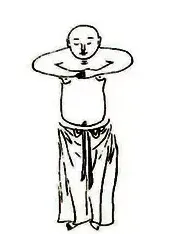
Both arms bend at the elbows, slowly raising them to the chest in a hugging ball posture, with wrists bent and palms facing up, fingers pointing upwards, palms facing each other (about 10 cm apart). This action requires the shoulders, elbows, and wrists to be on the same plane, and perform this action 8-20 times according to breathing.
Secret: Stand upright, arms hugging the chest, qi calm and spirit collected, heart clear and demeanor respectful.
Second Posture: Heng Dan Jiang Mo Zhu
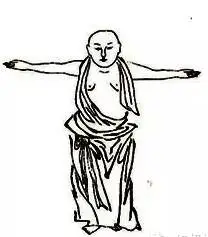
Feet shoulder-width apart, feet firmly planted, knees slightly relaxed; both hands slowly extend outward from the chest to the sides; palms facing outward; eyes looking forward; inhale while expanding the chest and pushing the arms back; exhale while curling the fingertips inward and pushing the palms outward. Repeat 8-20 times.
Secret: Toes gripping the ground, arms opening wide, heart calm and qi tranquil, eyes wide open.
Third Posture: Zhang Tuo Tian Men
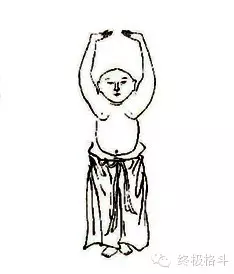
Feet apart, toes touching the ground, heels raised; both hands raised high above the head, palms facing up, with the middle fingers about 3 cm apart; shoulders relaxed, elbows bent, head tilted back, looking at the back of the hands. The tongue touches the upper palate, and the breath is even. Inhale while using hidden strength to push the hands upward, while both legs push down; exhale while relaxing the whole body, flipping the palms forward and downward. When finishing, both palms become fists, with the backs of the fists facing forward, and the upper limbs slowly retract to the waist, with the palms facing up. Repeat 8-20 times.
Secret: Palms supporting the heavenly gate, eyes looking up, strength surrounding the legs, biting down on the teeth without loosening. The tongue can produce saliva by touching the palate, and the nose can regulate breathing to feel at peace. When the two fists are slowly retracted, use strength to bring them back.
Fourth Posture: Zhai Xing Huan Dou
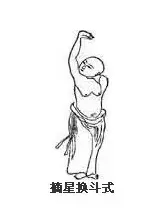
Step slightly forward with the right foot, forming a diagonal with the left foot; lean slightly to the left; bend the knee, lift the right heel, and sink the body down into a right empty step. Raise the right hand high, palm facing down, head slightly tilted to the right, eyes gazing at the palm; the left arm bends at the elbow, naturally resting behind the back. Inhale while lifting the head, and pushing the shoulders back; exhale while relaxing the whole body, then switch sides to practice. Repeat 5-10 times.
Secret: One hand supports the sky, palm covering the head, and the eyes gaze from within the palm. Breathe in through the nose, adjusting the breath frequently, and use strength to retract the left and right sides.
Fifth Posture: Dao Zhuan Jiu Niu Wei
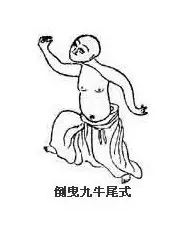
Step forward with the right foot, bending the knee into a right bow stance. The right hand forms a fist, raised to the front above the head, eyes watching the fist; the left hand forms a fist, with the left arm bent and hanging down behind. Inhale while tightly gripping both fists inward, bringing the right fist to the right shoulder and the left fist down behind; exhale while relaxing both fists and arms back to the preparatory position. Then turn the body to the left, alternating hands. Repeat 5-10 times, coordinating with the breath.
Secret: Both legs extend back and bend forward, the lower abdomen circulating qi and relaxing; strength lies in the arms, and the eyes must focus on the fists.
Sixth Posture: Chu Zhua Liang Chi
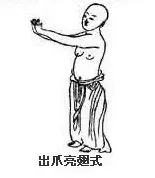
Stand with feet apart, arms extended forward, palms facing forward, fingers spread apart, and the tiger’s mouth facing each other. The eyes glare straight ahead, and the heels are raised to support the weight. Then slowly separate the palms, raising the upper limbs to form a straight line, palms facing outward, and then lower the heels back to the ground. Inhale while extending the palms with hidden strength, fingers curling backward; exhale while relaxing the arms and palms. Repeat 8-12 times.
Secret: Stand tall with fierce eyes, pushing the hands forward; when retracting strength, the practice must be complete seven times.
Seventh Posture: Jiu Gui Ba Ma Dao
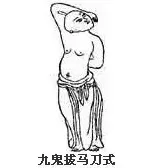
With toes touching, heels apart in a V-shape; both arms form a cross in front of the chest. The left hand bends at the elbow and moves back, forming a hook behind, with the fingertips pointing upwards; the right hand bends at the elbow and extends back, grasping the left hand’s fingers, forming a neck-hugging position. The toes grip the ground, and the body leans forward as if drawing a sword. Inhale while pulling both hands tightly, and exhale while relaxing. Alternate sides. Repeat 5-10 times.
Secret: Tilt the head and bend the elbow, hugging the head and neck; retracting from the head, do not mind the strength; alternate sides, keeping the body straight and the qi calm.
Eighth Posture: San Pan Luo Di
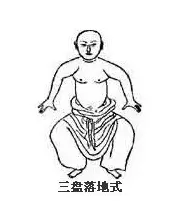
Step sideways with the left foot, bending the knee into a horse stance. Keep the upper body straight, hands on the waist, then bend the elbows and flip the palms upward, raising the forearms as if holding a heavy object; pause for a moment, then flip the palms downward, extending the forearms and relaxing as if putting down a heavy object. Perform the action with breathing, inhaling as if holding an object, and exhaling as if putting it down, repeating 5-10 times. When finishing, slowly straighten the legs, retract the left foot, and bring the feet together to stand upright.
Secret: The hard palate supports the tongue, eyes wide open, feet apart in a squatting position, hands pressing down as if grabbing; both palms flip up, and the eyes glare while the mouth is closed, standing up without tilting.
Ninth Posture: Qing Long Tan Zhua
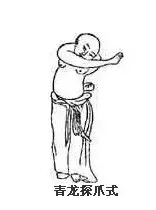
Stand with feet apart, both hands forming protective fists at the waist. Extend the right hand forward to the left front, fingers curled into a hook, while the upper body turns left. The waist rotates from left to right, and the right hand moves in a horizontal circle from left to right. When the hand reaches the front, lean the upper body forward while exhaling; when the hand reaches the left side, straighten the upper body while inhaling. Alternate sides, performing the opposite action. Repeat 5-10 times.
Secret: The green dragon extends its claws, emerging from the left; practitioners should emulate this, keeping the palms flat and the qi stable; strength surrounds the shoulders and back, gathering below the knees; eyes focused straight ahead, breathing adjusted to be tranquil.
Tenth Posture: Wo Hu Pu Shi
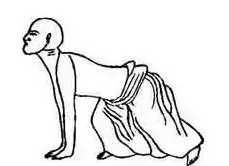
Step to the right with the right foot, bending the right knee into a right bow and left lunge position; lean the upper body forward, supporting the ground with both hands, head slightly raised, eyes focused downward. Inhale while extending both arms straight, raising the upper body as far forward as possible, shifting the center of gravity forward; exhale while bending the elbows, lowering the chest, and retracting the upper body, shifting the center of gravity backward, preparing to pounce. Repeat this action, coordinating with breathing, with both arms bending and extending, the upper body rising and falling, as if a tiger pouncing on its prey. After repeating 5-10 times, switch to the left bow and right lunge position, performing the same actions as before.
Secret: Both feet squat as if tilting, bending and extending the left leg alternately; raise the head and chest to prepare for the forward position, keeping the back straight and the waist level; breathe evenly, with fingertips touching the ground for support; the dragon descends and the tiger pounces, learning the true form is also beneficial.
Eleventh Posture: Da Gong Shi
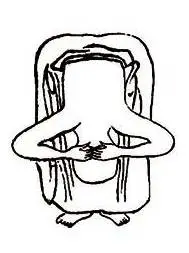
Stand with feet apart, toes pointing inward. Both hands raise slowly to the sides and upwards, embracing the back of the head, fingers tapping the back of the brain for a moment. Coordinate with breathing to perform bending actions; inhale while straightening the body, looking forward, as if lifting an object; exhale while bending the knees and bowing, using both hands to push the head down between the knees in a bowing position, without lifting the heels off the ground. Repeat according to physical strength, 8-20 times.
Secret: Both hands hold the brain, bending at the waist to the knees; the head only probes under the hips, the mouth biting the teeth; covering the ears to listen to the cold, adjusting the qi to be relaxed; the tongue tip still touches the palate, strength lies in the bent elbows.
Twelfth Posture: Gong Wei Shi
Stand with legs apart, both hands raise slowly from the chest to above the head, looking at the palms as they move, standing upright without arching the chest or protruding the abdomen; fingers interlock, wrists rotate, palms facing upwards, leaning back, bending the waist, looking upwards; then bend the upper body forward, arms hanging down, pushing the palms to the ground, raising the head and glaring. Exhale while bending down, lifting the heels slightly off the ground; inhale while standing up, heels touching the ground; repeat 21 times. Finish by standing upright, arms raised to the sides, bending and stretching 7 times.
Secret: Knees straight, arms extended, pushing hands from the ground; eyes glaring and head raised, concentrating the mind; rise and stomp the feet, 21 times; stretch the arms to the sides, aiming for seven; then practice sitting, crossing the legs and gazing down; focus on the heart, breathing through the nose; remain still before rising, preparing for the practice.
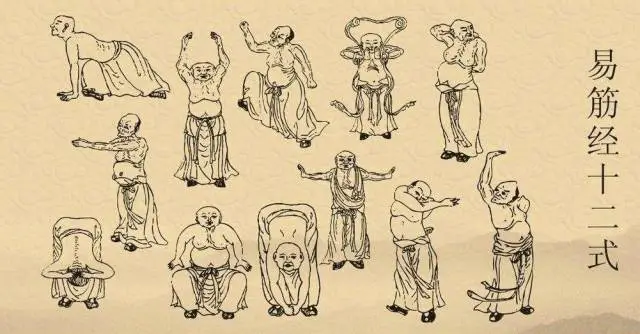
Introduction to the Practice
1. First Posture: Wei Tuo Xian Chu
(1) Secret: Stand upright, arms hugging the chest, qi calm and spirit collected, heart clear and demeanor respectful.
(2) Action Posture:
① Preparatory Stance: Stand with feet parallel, shoulder-width apart, knees slightly bent, arms naturally hanging down at the sides, fingers slightly bent and together, eyes looking straight ahead, then relax and gently close the eyes as if hanging a curtain. Keep the mind calm and the spirit serene, cleansing the heart and filtering thoughts, keeping the heart clear and demeanor respectful. Relax the entire body from head to toe, including the neck, shoulders, arms, chest, abdomen, hips, thighs, calves, and feet, ensuring no tension in the body, no distracting thoughts, and the spirit focused inward.
Then practice internal observation and relaxation, focusing the spirit inward, guiding qi and blood to the center, feeling the mind clear and fresh like morning dew.
Guide the qi downward, observing the throat, feeling the neck relax.
Guide the qi downward, observing the lower dantian, feeling the chest open and the spirit refreshed.
Guide the qi downward, observing the spleen, feeling warmth in the middle burner and comfort in the stomach.
Guide the qi downward, observing the lower dantian, feeling the warmth of the life gate, with abundant qi and warmth in the abdomen.
Guide the qi downward, observing the perineum, feeling it relax.
Guide the qi down the inner sides of both legs, observing the Yongquan point, feeling boundless vitality surging upward.
② Hugging the Chest: Slowly raise both arms in front, palms facing each other at shoulder width, arms straight, then bend the elbows, allowing them to drop naturally, slowly bringing the hands inward to about a fist’s distance from the chest, fingertips overlapping, thumbs lightly touching, palms facing inward. At this point, relax the shoulders, drop the chest, and sink the qi to the dantian, with the tongue touching the upper palate and a slight smile on the face.
2. Second Posture: Wei Tuo Xian Chu
(1) Secret: Toes gripping the ground, arms opening wide, heart calm and qi tranquil, eyes wide open.
(2) Action Posture:
① Following the previous posture, turn the palms downward, fingertips facing each other, and slowly lower them to the lower abdomen while guiding the qi downward. The palms separate to the sides, turning palms upward, slowly raising them to shoulder height, with the eyes looking straight ahead, gazing into the distance, tongue relaxed, waist and hips relaxed, toes gripping the ground as if rooting. The whole body should be relaxed, the heart calm, eliminating distractions and discarding all attachments.
3. Third Posture: Wei Tuo Xian Chu
4. (1) Secret: Palms supporting the heavenly gate, eyes looking up, strength surrounding the legs, biting down on the teeth without loosening; the tongue can produce saliva by touching the palate, and the nose can regulate breathing to feel at peace. When the two fists are slowly retracted, use strength to bring them back.
(2) Action Posture:
① Palms supporting the heavenly gate, looking up: Following the previous posture, raise both arms, palms facing each other, turning palms upward, fingers facing each other, tongue touching the upper palate, looking up at the sky, eyes gazing beyond the nine heavens, heels raised, toes touching the ground.
② Lowering the palms to guide qi: Both palms turn downward, elbows slightly bent, head upright, eyes looking straight ahead, tongue relaxed, both hands slowly pressing down to the lower abdomen, the spirit returning from the nine heavens, penetrating from the crown to the throat, spinal cord to the tailbone, along both legs to the Yongquan point. As the qi descends, the heels follow.
4. Fourth Posture: Zhai Xing Huan Dou
(1) Secret: Both hands supporting the sky, covering the head, and the eyes looking from within the palms; breathe in through the nose, adjusting the breath frequently, and use strength to retract the left and right sides.
(2) Action Posture:
① Both hands supporting the sky: The right hand slowly raises upward along the right side of the body, palm facing the sky, fingers pointing left, relaxing the shoulders and extending the left arm, keeping the left palm close to the life gate. The tongue touches the upper palate, looking up at the back of the hand, gazing through the back of the hand at the nine heavens above, the body stretching upward and downward from the life gate.
② Lowering the head to guide qi: The right palm turns downward, bending the elbow, head upright, tongue relaxed, eyes looking straight ahead or gently closed, while the spirit returns to the center. After practicing for a long time, when practicing continuously with both hands supporting the sky, one can feel the sensation of “the person in the qi, and the qi in the person,” achieving a sense of unity between the internal and external qi. Relax the waist, and the left palm’s Laogong point will emit qi, similar to the previous posture of lowering the palms to guide qi.
The left hand’s action is the same as the right hand’s action, but mirrored.
5. Fifth Posture: Dao Zhuan Jiu Niu Wei
(1) Secret: Both legs extending back and bending forward, the lower abdomen circulating qi and relaxing; strength lies in the arms, and the eyes must focus on the fists.
(2) Action Posture:
① Step to the left with the left foot into a left bow stance. At the same time, raise the left hand into a fist above the head, slightly above the top of the head, with the fist facing inward, bending the elbow. The angle between the forearm and upper arm should be slightly greater than a right angle. The elbow should not go past the knee, and the knee should not go past the foot, forming a semicircle, with both legs observing the left fist. The right hand forms a fist, extending the elbow backward, with the fist facing backward, the two fists forming a twisted rope shape, called a spiral neck. Relax the shoulders, keeping both shoulders level and aligned. Keep the back straight, waist relaxed, chest slightly concave, storing qi in the lower abdomen, breathing evenly, and the tongue lightly touching the upper palate.
② Guide the qi downward, relaxing both fists into a half-fist position. The tongue drops from the upper palate, shoulders and waist relax, the left hand’s Laogong point emits qi, and the eyes close. The qi flows from the Tianmu point into the brain, spinal cord, and leg bones, reaching the Yongquan points in both feet.
③ Turn to the right, performing the same actions as before, but mirrored.
6. Sixth Posture: Chu Zhua Liang Chi
(1) Secret: Stand tall with fierce eyes, pushing the hands forward; when retracting strength, the practice must be complete seven times.
(2) Action Posture:
1. Form a fist to protect the waist from the first posture’s preparatory stance, leaning the upper body forward, with both arms hanging down in front, both hands forming fists, slowly raising them from the front to the waist, with the fist’s heart facing upward. At the same time, coordinate with the breath, keeping the body straight and the chest open, the tongue lightly touching the upper palate. For young and strong individuals or those aiming to enhance strength, tighten the fists as they are raised.
2. Transform both fists into palms, slowly pushing forward until the palms face forward, with the wrists bent and fingers curled, at shoulder height, eyes looking straight ahead, extending into the distance.
3. Relax the wrists, forming a soft palm, with fingers slightly bent, bending the elbows, and slowly retracting both hands to the sides of the chest, as if the tide is returning to the sea, with eyes gently closed and the tongue lightly touching the upper palate, coordinating with slow inhalation.
7. Seventh Posture: Jiu Gui Ba Ma Dao
(1) Secret: Tilt the head and bend the elbow, hugging the head and neck; retracting from the head, do not mind the strength; alternate sides, keeping the body straight and the qi calm.
(2) Action Posture:
① The right hand is placed on the back, palm facing outward, at the waist. The left hand is raised above the head, bending the elbow to hug the head, pressing the fingers against the right ear, and opening the left armpit. At the same time, the head, neck, waist, and back twist to the left rear, with the eyes looking at the right heel. The tongue lightly touches the upper palate, and pause for a moment.
② Twist back to the center, looking up. The eyes extend into the distance. The tongue lightly touches the upper palate, and the body remains straight and the qi calm. Both hands slowly lower along the front of the body, returning to the preparatory stance. The actions 3, 4 are the same as 1, 2, but mirrored.
8. Eighth Posture: San Pan Luo Di
(1) Secret: The hard palate supports the tongue, eyes wide open, feet apart in a squatting position, hands pressing down as if grabbing; both palms flip up, and the eyes glare while the mouth is closed, standing up without tilting.
(2) Action Posture:
① Same as the first posture’s preparatory stance, bending the waist and squatting down, while both palms separate to the sides of the hips, fingertips pointing to the left and right sides (slightly forward), with the tiger’s mouth supporting a circle, eyes looking forward, extending into the distance. The upper body is empty, and the lower body is solid, with the chest empty and the abdomen solid, relaxing the waist and tucking the hips, storing qi in the lower abdomen. Ensure the top, shoulders, and heart are level and calm. Practitioners of stillness can close their eyes and focus their spirit, as the copper bell qi practice is derived from this, and can also be practiced as a standalone stance. Both legs should straighten, flipping the palms up as if holding a thousand pounds. At the same time, the qi should be guided, the tongue touching the upper palate, eyes looking straight ahead, and the whole body relaxed.
Lower the palms and bend the knees to press down (returning to the horse stance), coordinating with breathing, repeating the squat and rise 3 times. Young practitioners should squat fully, rising slowly while raising their fists.
9. Ninth Posture: Qing Long Tan Zhua
(1) Secret: The green dragon extends its claws, emerging from the left; practitioners should emulate this, keeping the palms flat and the qi stable; strength surrounds the shoulders and back, gathering below the knees; eyes focused straight ahead, breathing adjusted to be tranquil.
(2) Action Posture:
Stand with feet apart, both hands forming protective fists at the waist. Extend the right hand forward to the left front, fingers curled into a hook, while the upper body turns left. The waist rotates from left to right, and the right hand moves in a horizontal circle from left to right. When the hand reaches the front, lean the upper body forward while exhaling; when the hand reaches the left side, straighten the upper body while inhaling. Alternate sides, performing the opposite action. Repeat 5-10 times.
10. Tenth Posture: Wo Hu Pu Shi
(1) Secret: Both feet squat as if tilting, bending and extending the left leg alternately; raise the head and chest to prepare for the forward position, keeping the back straight and the waist level; breathe evenly, with fingertips touching the ground for support; the dragon descends and the tiger pounces, learning the true form is also beneficial.
(2) Action Posture:
Lean the upper body forward, both hands forming fists, slowly raising them from the front to the waist, with the fist’s heart facing upward. At the same time, coordinate with the breath, keeping the body straight and the chest open, the tongue lightly touching the upper palate. For young and strong individuals or those aiming to enhance strength, tighten the fists as they are raised.
2. Step forward with the left foot, transitioning into a left bow stance, while the arms rotate and extend forward, palms at chest height, eyes focused on both hands. As you extend, exhale forcefully.
3. Continue to lean forward, keeping the back straight, exhaling completely, and pressing both hands down to the sides of the left foot. Raise the head slightly, with eyes looking straight ahead and into the distance. Repeat the actions 3 times, switching to the right bow stance and performing the same actions as before.
11. Eleventh Posture: Da Gong Shi
(1) Secret: Both hands hold the brain, bending at the waist to the knees; the head only probes under the hips, the mouth biting the teeth; covering the ears to listen to the cold, adjusting the qi to be relaxed; the tongue tip still touches the palate, strength lies in the bent elbows.
(2) Action Posture:
Stand with feet apart, toes pointing inward. Both hands raise slowly to the sides and upwards, embracing the back of the head, fingers tapping the back of the brain for a moment. Coordinate with breathing to perform bending actions; inhale while straightening the body, looking forward, as if lifting an object; exhale while bending the knees and bowing, using both hands to push the head down between the knees in a bowing position, without lifting the heels off the ground. Repeat according to physical strength, 8-20 times.
12. Twelfth Posture: Gong Wei Shi
Stand with legs apart, both hands raise slowly from the chest to above the head, looking at the palms as they move, standing upright without arching the chest or protruding the abdomen; fingers interlock, wrists rotate, palms facing upwards, leaning back, bending the waist, looking upwards; then bend the upper body forward, arms hanging down, pushing the palms to the ground, raising the head and glaring. Exhale while bending down, lifting the heels slightly off the ground; inhale while standing up, heels touching the ground; repeat 21 times. Finish by standing upright, arms raised to the sides, bending and stretching 7 times.
Secret: Knees straight, arms extended, pushing hands from the ground; eyes glaring and head raised, concentrating the mind; rise and stomp the feet, 21 times; stretch the arms to the sides, aiming for seven; then practice sitting, crossing the legs and gazing down; focus on the heart, breathing through the nose; remain still before rising, preparing for the practice.

Full Text of the Yi Jin Jing
Translation: The Buddha’s essence states that to attain the right fruit, there are two foundational aspects: one is Qing Xu (清虚) and the other is Tuo Huan (脱换). To achieve Qing Xu means to be free of obstacles, and to achieve Tuo Huan means to be unimpeded. Without obstructions and barriers, one can enter and exit meditation. Knowing this, one can progress on the path. The so-called Qing Xu refers to Xisui (洗髓); Tuo Huan refers to Yi Jin (易筋).
The concept of Xisui states that when a person is affected by desires, they fall into a physical form, and all organs and limbs become tainted by impurities. It is essential to cleanse and purify completely, leaving no blemish, before one can step into the extraordinary and sacred realm; without this, one cannot progress on the path. The so-called Xisui is to purify the internal; Yi Jin is to strengthen the external. If one can achieve internal purity and external strength, attaining longevity is within reach, and there is no worry about failure.
Furthermore, Yi Jin refers to the muscles and bones of the human body, which are received from birth. There are various conditions: some have loose muscles, some have tight muscles, some have weak muscles, some have contracted muscles, some have strong muscles, some have relaxed muscles, some have firm muscles, and some have harmonious muscles, all differing from birth. If the muscles are loose, one becomes ill; if the muscles are tight, one becomes thin; if the muscles are weak, one becomes frail; if the muscles are contracted, one perishes; if the muscles are strong, one becomes robust; if the muscles are relaxed, one grows; if the muscles are firm, one becomes strong; if the muscles are harmonious, one remains healthy. If a person has internal impurities and obstacles, and lacks external strength, how can they enter the path? Therefore, to enter the path, one must first practice Yi Jin to strengthen the body and enhance the internal to assist the external. Otherwise, the path will be difficult to attain.
The term Yi is profound. Yi refers to the principles of yin and yang. Courage is the ease of change. The changes of Yi exist in yin and yang, but the changes of yin and yang actually exist in humans. Manipulating the sun and moon in a pot, grasping the yin and yang in the palms. Therefore, the two verticals are in people, and nothing cannot be changed. Thus, the virtual and the real can be changed; the hard and the soft can be changed; the still and the moving can be changed. The high and low can be changed in their rise and fall; the later and earlier can be changed in their speed; the smooth and the rough can be changed in their coming and going; the dangerous can be changed to safety; the chaotic can be changed to order; misfortune can be changed to fortune; loss can be changed to preservation; the fate can be changed to recovery; the heavens and the earth can be changed to reversal; everything is the power of Yi. As for the muscles and bones of the human body, can they not be changed?
However, muscles are the meridians of the human body. Outside the joints, inside the muscles, all limbs and bones are connected by muscles, and all meridians are linked, circulating blood and qi, serving as the external support for the spirit. For instance, the shoulders can bear weight, the hands can grasp, and the feet can walk; the vitality and agility of the whole body are all due to the strength of the muscles. How can one allow them to be loose, tight, weak, or frail? And if one is ill, thin, frail, or weak, how can they enter the path? The Buddha uses the method of recovery and transformation to allow those with tight muscles to change to relaxed, those with weak muscles to change to strong, those with loose muscles to change to harmonious, those with contracted muscles to change to long, and those with weak muscles to change to strong. Even a soft and muddy body can become as strong as iron and stone; this is the power of Yi. This is the benefit of the body and the foundation of the sage; this is only one aspect. Therefore, yin and yang are held by humans, and yin and yang cannot be self-generated. Each person becomes their own, and one should not be ensnared by yin and yang. Driven by blood and qi, one can transform into a body of gold and stone. Without internal obstacles and external barriers, one can begin to enter meditation and exit meditation. However, this practice is not trivial. There are gradual stages, methods of internal and external, applications of qi, actions of beginning and ending, and even the use of medicines and tools, seasonal timing, diet, and daily living, all have their own evidence. Those who enter this door should first establish faith, then set intentions, courageously advance, diligently practice according to the method, and they will surely ascend to the sacred realm.
Ban Ci Mi Di states: This article discusses the original intention of Master Bodhidharma, explaining the essence of Yi Jin. The translation is presented without adding personal opinions or creating any phrases. The subsequent sections detail the practice methods, with the original text’s meanings fully explained. If one encounters a wise monk from the West, they may further contemplate it.
Discussion on the Membrane
The human body consists of the internal organs and the external limbs; internally, there are the five organs and six bowels, and externally, there are the muscles and bones, forming a complete body. The internal essence, qi, and spirit, and the external muscles and bones, all contribute to the body. As for the organs, the muscles and bones govern them; outside the muscles and bones, the flesh governs them, and within the flesh, the blood vessels govern them; everything that moves and is lively throughout the body is governed by qi. Therefore, the practice of cultivation focuses on nurturing blood and qi as the primary goal. Just as the heavens give birth to all living things, each follows the principles of yin and yang, and all things are born; how much more so for humans, and even more so for cultivation. Moreover, the essence, qi, and spirit are formless, while the muscles and bones are the physical body.
This method must first cultivate the physical form as a support for the formless; nurturing the formless serves as a support for the physical. They are one and two, and two and one. If one solely cultivates the formless and neglects the physical, it is not possible; if one solely cultivates the physical and neglects the formless, it is even more impossible. Therefore, the physical body must obtain the formless qi, relying on each other without conflict, to form an indestructible body. If they conflict and do not rely on each other, the physical will transform into the formless. Thus, cultivating muscles must also cultivate the membrane, and cultivating the membrane must cultivate qi. However, cultivating muscles is easy, while cultivating the membrane is difficult; cultivating the membrane is difficult, and cultivating qi is even more difficult. One must first establish a firm foundation in the most difficult and chaotic areas, then recognize the true method in the stillness and stability.
It is essential to nurture the original qi, guard the internal qi, and preserve the righteous qi. Protect the kidney qi, nourish the liver qi, regulate the lung qi, manage the spleen qi, elevate the clear qi, lower the turbid qi, and close off the evil and unwholesome qi. Do not harm the qi, do not go against the qi, and do not worry, think, or become angry to damage the qi. Ensure the qi is clear and balanced, balanced and harmonious, harmonious and smooth, able to flow through the muscles, intertwining with the membranes, leading to a lively and agile body, with no place unresponsive. When the qi arrives, the membrane rises; when the qi flows, the membrane expands. If the membrane can rise and expand, then the membrane and muscles will be equally strong and firm.
If one cultivates muscles without cultivating the membrane, the membrane will have no master; if one cultivates the membrane without cultivating muscles, the membrane will have no support; if one cultivates muscles and membranes without cultivating qi, the muscles and membranes will become muddy and unable to rise; if one cultivates qi without cultivating muscles and membranes, the qi will become weak and unable to circulate through the muscles and meridians. If the qi cannot flow through, then the muscles cannot be strengthened; this is the mutual use and intricate path.
Once the muscles have risen, one must double the effort to ensure that all membranes throughout the body can rise, becoming equally strong and firm, adhering to the skin and solidifying within; this is the mutual relationship of mother and child. Otherwise, if the muscles are strong without support, it is like a plant growing without soil; how can one claim to have achieved full success?
Ban Ci Mi Di states: This article discusses the cultivation of muscles, prioritizing the cultivation of membranes, and the cultivation of membranes prioritizing the cultivation of qi. However, this membrane is not to be confused with the fat membrane; it refers to the muscle membrane. The fat membrane is an internal substance, while the muscle membrane is an external substance. Muscles connect the limbs, while membranes wrap around the bones. In comparison, the membrane is softer than the muscles; in comparison, the flesh is stronger than the membrane. The membrane resides within the flesh and outside the bones, wrapping around the bones and supporting the flesh. This is the situation; those who practice this must ensure that the qi flows through the membranes, protecting the bones, strengthening the muscles, and uniting them into one body, which is called full success.
Discussion on Internal Strength
Internal and external are opposites, strength and weakness are opposites, and strength can last long. Internal and external are compared, and the external should not be neglected. Internal strength refers to firmness, while external strength refers to courage. Firmness and courage are true courage. Courage and firmness are true firmness. Firmness and courage, courage and firmness, form a body that is indestructible through countless tribulations, which is the body of a diamond.
In cultivating internal strength, there are three principles: the first is to maintain the middle path. To guard the middle means to focus on accumulating qi. Accumulating qi involves the eyes, ears, nose, tongue, body, and mind. The key to this is in the use of kneading, which will be detailed later. When kneading, it is advisable to loosen the clothing and lie on the back, placing one palm under the chest and abdomen, which is called the center. Only this center is where qi is stored, and it must be guarded. The method of guarding is to focus the gaze, concentrate the hearing, regulate the breath, close the mouth, relax the body, and lock the mind, keeping the limbs still, with a single thought focused on the middle path, gradually eliminating all distracting thoughts until one reaches a state of stillness; this is called guarding. This is the combined method. Kneading is thus, and the essence, qi, and spirit of the whole body are concentrated here. Over time, this will naturally form a solid foundation. If distracting thoughts are numerous, and one is distracted by worldly affairs, the spirit and qi will not concentrate, leading to a loss of the kneading effect; what benefit is there in that?
The second principle is to avoid other thoughts. Within the human body, the spirit, qi, and blood cannot act autonomously; they all follow the mind. When the mind acts, they act; when the mind stops, they stop. During kneading, the mind follows the hands; this is the combined method. If the mind is relaxed in the limbs, the accumulated essence and spirit will scatter to the limbs, leading to external strength rather than internal strength. If one kneads without accumulating, it will also weaken the kneading; what benefit is there?
The third principle is to wait for fullness. Both kneading and guarding are for accumulating qi. Once qi is accumulated, the spirit and blood vessels will all attach to it, guarding it without scattering, kneading for a long time, and the qi will be stored in the center without overflowing. When qi accumulates, strength naturally accumulates; when qi is full, strength surrounds. This qi is what Mencius referred to as the utmost and the strongest, filling the space between heaven and earth; this is our vast qi. If one has not yet reached fullness, and the mind wanders outside, scattering to the limbs, not only will external strength be incomplete, but internal strength will also be weak, leading to a lack of both.
Ban Ci Mi Di states: At birth, humans are originally good. If desires and distracting thoughts divide them, then their original face is completely erased, and the eyes, ears, nose, tongue, body, and mind all lose their spiritual connection, obscuring their wisdom, making it impossible to realize the path. This is why Master Bodhidharma meditated facing the wall at Shaolin for nine years, not indulging in the desires of the eyes and ears. When the eyes and ears are not indulged, the monkey and horse are bound by their chains. Therefore, Master Bodhidharma obtained this true method, allowing him to return to the West and attain the right fruit. This article is the heart seal of Master Bodhidharma, with the true method in guarding the center. Its application lies in focusing the gaze in the seven phrases. If one can practice according to the method, even the foolish will become wise, and the weak will become strong, and one can ascend to the world of ultimate bliss.
Kneading Method
The purpose of kneading is to sharpen the muscles and bones. Sharpening refers to kneading. The method has three stages, each lasting a hundred days.
The first stage of kneading has seasonal timing. For example, starting in the spring month, during the practice, it may be cold in spring, making it difficult to practice naked; one can only loosen the clothing. Then practice in mid-February, when the weather gradually warms, allowing for practice; gradually warming leads to smoothness, and one can practice freely.
The second stage of kneading has a fixed pattern. In the human body, the right side corresponds to qi and the left side corresponds to blood. In kneading, it is advisable to push from the right side of the body to the left, which helps to push qi into the blood, allowing for smooth circulation; it also helps to widen the stomach, allowing it to take in more qi; and it also takes advantage of the right hand’s strength, using it without labor.
The third stage of kneading should be light and gentle. Although it is called human effort, it should follow the principles of heaven. The heavens give birth to all things gradually, not abruptly; qi arrives naturally, and things develop gradually. Kneading should be done in this manner, taking gentle and gradual movements, avoiding heavy or deep pressure; over time, one will naturally achieve this, which is the combined method. If the pressure is too heavy, it may injure the skin, leading to rashes; if it is too deep, it may injure the muscles and membranes, leading to swelling; caution is essential.
Essence Gathering Method
The essence of the sun and the flower of the moon, the two energies merge to create all things. The ancients were adept at gathering essence, and over time, they became immortal. The method is secret, and the world knows little about it. Even if there are those who understand, they often lack determination and perseverance, leading to a loss of potential, and few succeed.
For those practicing internal cultivation, from the beginning of practice to success, throughout their lives, regardless of busyness or external matters, if the essence gathering practice is uninterrupted, the path to immortality is not difficult to achieve. The reason for gathering essence is to obtain the essence of yin and yang, enhancing our wisdom, allowing stagnation to gradually dissipate, and promoting clarity and longevity, preventing all diseases, which brings great benefits.
The method: Gather essence from the new moon, which is when it intersects with the beginning of the month, as its energy is fresh and suitable for gathering the essence of the sun. Gather essence from the full moon, which is when the metal and water are full, as its energy is strong and suitable for gathering the essence of the moon. If the new moon or full moon encounters rain or is not convenient, one can gather on the second or third day, or the sixteenth or seventeenth day, which is still acceptable. If it exceeds these six days, the sun will decline and the moon will wane, becoming empty and insufficient for gathering. For gathering the essence of the sun, it is best to do so during the Yin and Mao hours, facing upwards, adjusting the breath evenly, gently inhaling the light essence, filling the mouth, closing the breath, concentrating the spirit, and swallowing slowly, sending it to the center; this is called one swallow. Repeat this seven times, remaining still for a while, then rise and act, without any hindrance. For gathering the essence of the moon, follow the same method, during the Xu and Hai hours, swallowing seven times. This is the natural benefit of heaven and earth, and only those with perseverance can enjoy it; only those with faith can utilize it. This is a significant practice within the method, and one must not neglect it.

